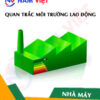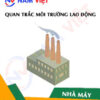Occupational environment monitoring at the electric motor factory
99,000 ₫
Note: The above price is calculated for one sample, the price may vary depending on the area of the environment that needs monitoring and the movement of the market. For more accurate price support, please refer to the quotation table or contact directly with our consulting staff.
Environmental monitoring of an electric motor factory is a session of collecting, analyzing, and evaluating factors in the workplace that may harm workers health.
Table of Contents
Toggle1. Overview of electric motor factory
a. What is an electric motor factory?
Factory electric motor is a production facility that manufactures types of electric motors. An electric motor is a device that converts electrical energy into mechanical energy to perform motion or generate power. These electric motors can be used in many industries and various applications, including the automotive industry, aerospace industry, electronics industry, and electromechanical automation systems.
The electric motor factory usually has complex and automated production processes, including component processing, assembly, quality inspection, and final product packaging. The production stages include processing basic details such as motor housing, shaft, transmission, control system, and other components. After that, these details are assembled into units or complete motors and undergo strict quality control before being packaged and delivered to customers.

b. Production stages in the electric motor factory
The production stages in the electric motor factory include:
- Detail processing: Before assembly, the basic parts of the electric motor such as housing, shaft, transmission, and other components are processed. The processing may include cutting, grinding, milling, drilling, and other precision machining processes to create parts with high accuracy and durability.
- Assembly: After processing the parts, the units and components of the electric motor are assembled into units or complete motors. The assembly process includes joining details, attaching components such as bearings, brushes, cooling fans, and control systems. Assembly processes are usually carried out on production lines or according to customized assembly processes.
- Inspection and testing: After assembly, the electric motors are inspected for quality and tested to ensure that they operate properly and meet quality standards. Inspections include run testing, vibration testing, performance testing, and durability testing. This ensures that the electric motors meet the required specifications.
- Packaging and transportation: After inspection and testing, the electric motors are packaged into suitable packaging to protect them during transportation and storage. Packaging may include cartons, plastic packaging, pallets, or special transportation means. The packaged units are then transported to sales points or customers as required.

c. Types of machinery used in the electric motor factory
The types of machinery commonly used in the electric motor factory include:
- Lathe: The lathe is used to machine shafts and motor housings to create flat, round, and highly accurate surfaces.
- Milling machine: The milling machine is used to machine complex-shaped parts such as transmission, shafts, and other components of the electric motor.
- Grinding machine: The grinding machine is used to grind highly accurate parts such as shafts, bearings, and other important surfaces in the motor production process.
- Planer: The planer is used to create flat, smooth, and precise surfaces on electric motor parts.
- Sandblasting machine: The sandblasting machine is used to clean parts using compressed air pressure and sand particles. This process helps remove dust, dirt, and residues on the surface of electric motor parts.
- CNC machine: The CNC (Computer Numerical Control) machine is used to perform automated machining processes based on numerical control programs. CNC machines can carry out turning, milling, grinding, and drilling with high precision and efficiency.
- Inspection and testing machines: Special inspection and testing machines are used to check specifications, performance, vibration, and other quality standards of electric motors.

d. What occupational diseases may occur for workers in the electric motor factory?
Workers in the electric motor factory may suffer from some of the following occupational diseases:
- Respiratory diseases: This is a common risk due to exposure to dust and fumes generated from processing and the use of chemicals in electric motor production. Workers may develop pneumonia, asthma, sinusitis, or other respiratory issues.
- Skin diseases: Contact with chemicals such as oil, solvents, and cleaning agents can cause skin irritation, dermatitis, eczema, or allergic reactions.
- Ear diseases: Noise is a common issue in electric motor factories, creating risks of hearing damage. Workers may experience hearing loss, tinnitus, or other ear-related issues.
- Spinal and joint diseases: Working with heavy loads and muscle strain combined with incorrect working postures can cause spinal problems, back pain, osteoarthritis, and other musculoskeletal issues.
- Mental health and stress disorders: A stressful working environment can cause psychological problems such as stress, depression, anxiety, and reduced mental health.

e. Common types of electric motors on the market
There are many common types of electric motors on the market, including:
- Single-phase motor: Used in household appliances such as washing machines, refrigerators, fans, small water pumps, and other small applications.
- Three-phase motor: Widely used in industries such as manufacturing, processing, energy, and large applications. Three-phase motors have high efficiency, good stability, and strong operating capacity.
- Stepper motor: Used in applications requiring precise positioning, such as 3D printers, CNC machines, scanners, and position control devices.
- Asynchronous motor: A common type of motor used in many industrial applications. Asynchronous motors have high reliability, long lifespan, and good load capacity.
- Servo motor: Used in applications requiring high precision and accurate control of position and speed, such as CNC machines, robots, and automation systems.
- Synchronous motor: Often used in applications requiring synchronization with the driving power source, such as power grid synchronization systems and other industrial applications.
- Clock motor: Used in clocks, time measuring devices, and other small devices with time measuring and display functions.
2. Overview of occupational environment monitoring service
a. What is occupational environment monitoring in the electric motor factory?
Occupational environment monitoring (or occupational environment measurement) in the electric motor factory is the activity of collecting, evaluating, and analyzing measurement indicators of occupational environmental factors at the electric motor factory, in order to implement timely measures, minimize environmental harm to workers’ health, and prevent occupational diseases. Occupational environment monitoring is a mandatory regulation for electric motor factories.
Occupational environment monitoring plays the most important role in caring for, protecting, and improving workers’ health because the main resource of enterprises and the direct creators of profit are the workers. Workers frequently exposed to hazardous occupational factors exceeding permissible standards will have their health affected and may develop occupational diseases.
REGISTER FOR OCCUPATIONAL ENVIRONMENT MONITORING SERVICE
b. Occupational environment monitoring program of Nam Viet
The occupational environment monitoring program of Nam Viet is a program researched by monitoring engineers in the field of occupational safety and environmental protection. With the goal of ensuring workers’ health and safety, this program uses modern measurement methods to monitor air quality, water, microclimate, physical, and dust factors in the working environment. This is a very important program in ensuring a safe working environment and protecting workers’ health.
In addition, the occupational environment monitoring program of Nam Viet also plays an important role in researching and developing new solutions to improve the quality of the working environment. With the dedication and professionalism of the monitoring experts, Nam Viet’s exclusive monitoring program is becoming a breakthrough in the field of occupational safety management and environmental protection in Vietnam.

c. Standardization in the occupational environment measurement process
Standardization in the occupational environment measurement process of Nam Viet is a very important aspect in ensuring the quality of measurement results. To ensure the accuracy and reliability of measurement results, this program uses recognized standards and standardized procedures of Ho Chi Minh City Department of Health. This ensures that the collected data will be highly reliable in evaluating the working environment and making decisions to improve the working environment to protect workers’ health.
These standardized procedures also ensure that measurement results are carried out by monitoring specialists with high qualifications and many years of experience, helping managers and experts trust the results from An Toan Nam Viet and make accurate and valuable decisions in protecting workers’ health and the environment.
By applying standardization in the occupational environment measurement process, Nam Viet demonstrates its commitment to ensuring a safe working environment and protecting workers’ health, while also positively contributing to the development and improvement of occupational safety management and environmental protection quality in Vietnam.
d. Monitoring report results for electric motor factory
Occupational environment monitoring results are prepared according to Form No. 04, Appendix III issued together with Decree 44/2016/ND-CP and prepared in 02 copies: 01 copy sent to the labor facility that signed the contract for occupational environment monitoring and 01 copy kept at the monitoring organization.
The storage time for occupational environment monitoring results is in accordance with legal regulations, with records stored indefinitely.

e. Frequency of occupational environment monitoring according to legal regulations
According to Clause 2 Article 18 of the Law on Occupational Safety and Hygiene 84/2015/QH13, employers must conduct occupational environment monitoring to assess harmful factors at least once a year.
f. Deadline for submitting occupational environment monitoring results according to legal regulations
The deadline for submission is before December 31 every year, enterprises belonging to production facilities are required to submit occupational environment monitoring reports to the Department of Health in the locality where the production facility, business headquarters, and workers are located.
When there are changes in technological processes, production processes, or when renovating or upgrading labor facilities that may generate new harmful factors affecting workers’ health, enterprises belonging to production facilities must update occupational hygiene records regarding harmful factors that require occupational environment monitoring.
g. Penalty regulations for violations of occupational environment monitoring for employers
According to Article 27 of Decree No. 12/2022/ND-CP dated January 17, 2022, on administrative penalties in the field of labor, social insurance, and Vietnamese workers working abroad under contracts.
- Clause 2: A fine from 2,000,000 – 5,000,000 VND for employers who do not publicly announce to workers at the occupational environment monitoring site and the place of inspection, evaluation, and management of hazardous factors immediately after obtaining occupational environment monitoring results and results of inspection, evaluation, and management of hazardous factors at the workplace.
- Clause 3: A fine from 20,000,000 – 40,000,000 VND for employers who fail to conduct occupational environment monitoring to control harmful effects on workers’ health as prescribed by law.
- Clause 4: A fine from 40,000,000 – 60,000,000 VND for employers who collude with occupational environment monitoring organizations to commit fraud in occupational environment monitoring activities but not to the extent of criminal prosecution.
3. Harmful environmental factors for workers in the electric motor factory
In the electric motor factory, there are several harmful environmental factors that may affect workers’ health, including:
- Noise: Excessive noise from machinery operation and production processes in the factory may cause hearing problems and lead to stress and fatigue for workers.
- Dust and fine particles: The process of machining and handling materials in the factory sometimes generates dust, fine particles, and chemicals that may cause respiratory irritation, pneumonia, and other respiratory health issues.
- Chemicals: The use of chemicals such as solvents, detergents, plasticizers, lubricants, and coatings in the production process may cause risks of exposure and absorption of toxic substances through skin, inhalation, or eye contact, leading to harmful effects on the body and occupational diseases.
- Temperature and humidity: Working environments that are too hot, too cold, or highly humid may pose risks to workers’ health, causing heat stress, dehydration, or impacts on the respiratory system.
- Vibration: Machinery operating in the factory may generate vibrations, especially in large machining processes. Excessive vibrations may cause muscular, skeletal, and nervous strain for workers.
- Lighting: Strong, glaring, and uneven lighting may strain the eyes and cause discomfort for workers.
REGISTER FOR OCCUPATIONAL ENVIRONMENT MONITORING SERVICE
4. Measures to improve the working environment in the electric motor factory
To improve the working environment in the electric motor factory and protect workers’ health, the following measures may be applied:
- Ensure safety regulations: Establish and comply with occupational safety regulations, including the use of personal protective equipment, safety instructions, and work procedures.
- Noise control: Apply technical measures such as soundproofing, rotating shifts, and providing ear protection equipment to reduce noise to a safe level.
- Dust and fine particle management: Apply effective dust extraction systems, provide air purifiers, and ensure the use of respiratory protective equipment.
- Chemical management: Apply safety measures in storing, using, and handling chemicals. Ensure proper usage instructions, provide suitable protective equipment, and implement regular cleaning procedures.
- Adjust temperature and humidity: Ensure the air conditioning system operates properly to maintain ideal temperature and humidity in the working environment.
- Lighting adjustment: Use appropriate natural and artificial lighting to ensure a well-lit working environment without glare.
- Vibration control: Apply technical measures such as vibration isolation, use of vibration pads, and provide suitable personal protective equipment.
- Training and education: Provide safety training, equipment usage instructions, work procedures, and health protection measures for workers.
- Regular inspection and maintenance: Conduct regular inspections, maintenance, and cleaning of machinery and equipment to ensure safe and effective operation.
- Regularly organize occupational environment monitoring in factories, collect and analyze harmful factors for workers, and adjust to reduce risks in order to prevent occupational diseases.
5. Benefits of regular monitoring in the electric motor factory
An Toan Nam Viet provides your enterprise with excellent benefits when using occupational environment monitoring services in accordance with Decree 44/2016/ND-CP on the management and control of harmful factors in the working environment affecting workers.
- Your enterprise can proactively control harmful factors in workshops or factories.
- Receive consulting and recommendations on measures to reduce harmful factors and improve the quality of the working environment.
- Indirectly protect human resources, the key factor in the enterprise’s development process.
- Reduce the harmful effects of occupational diseases on human health, thereby reducing treatment costs in the future.
- Workers’ health is improved, leading to guaranteed and maintained product quality and productivity.
- Comply with occupational safety laws and avoid legal risks.
- Create credibility and professionalism in all aspects, thereby elevating your enterprise’s brand.
The occupational environment monitoring service of Nam Viet is the solution to minimize the harmful effects of occupational diseases, contributing to creating a healthy and high-quality working environment.

6. National occupational environment monitoring center
Occupational environment monitoring center of Nam Viet is a professional unit in monitoring and measuring the quality of the occupational environment throughout all provinces and cities in Vietnam. With a team of experienced monitoring specialists, the center uses modern measuring equipment, ensuring accuracy and reliability.
In addition to providing monitoring services, the center also supports customers in planning, handling, and monitoring occupational environment issues. With the motto “customers are the center,” the center focuses on customer satisfaction, meeting all customer needs, and committing to providing the best solutions for enterprises.
REGISTER FOR OCCUPATIONAL ENVIRONMENT MONITORING SERVICE
With investments in technology, equipment, and human resources, the monitoring center of Nam Viet has been and is becoming one of the reputable units in occupational environment monitoring in Ho Chi Minh City with the following goals:
- We always value brand reputation and the quality of our services and products.
- We provide customers with the best and most suitable solutions possible.
- Together with a team of experienced Masters and Engineers with expertise, we aim to protect the environment and bring benefits to enterprises.
- With the Nam Viet Monitoring team, your company will receive professional service from experts in the monitoring field, along with the best cost benefits.
The process of conducting occupational environment monitoring at Nam Viet includes the following basic steps:
- Before conducting occupational environment monitoring, our company always ensures that monitoring machinery and equipment are adjusted and calibrated in accordance with the law.
- Strictly follow the occupational environment monitoring process committed with the Department of Health.
- Report monitoring results honestly to the employer.
- In cases where occupational environment monitoring results do not ensure worker safety, Nam Viet will support with remedial solutions, and the workplace will implement as follows:
- Implement measures to improve working conditions to minimize the impact of harmful factors and prevent occupational diseases.
- Organize health check-ups to detect occupational diseases and work-related illnesses early for workers in unsafe working environments.
- Provide physical benefits for workers in accordance with labor laws.

7. Occupational environment monitoring service quotation
To help enterprises carry out occupational environment monitoring professionally and effectively, Nam Viet provides customers with a quotation table for occupational environment monitoring services with high quality and reasonable cost.
- Our monitoring quotation provides detailed information about the costs of the monitoring services we provide, including costs related to transportation, measurement, analysis, and reporting. Customers can be assured of the accuracy and reliability of the monitoring reports we provide.
- We are committed to always offering the most competitive and reasonable prices on the market, and we are always ready to provide quick and professional consultation to answer all questions about monitoring services.
- With the monitoring quotation from Nam Viet, customers can easily choose service packages suitable for their needs. We are committed to bringing customers the highest satisfaction with professional service quality.
No comments yet












Review Occupational environment monitoring at the electric motor factory
There are no reviews yet.